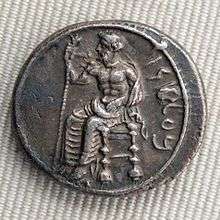Pharnabazus III

Pharnabazus III (in Greek Φαρνάβαζος; c. 370 BC - after 320 BC) was a Persian satrap who fought against Alexander the Great.
Youth
Pharnabazus was the son of Artabazus, satrap of Hellespontine Phrygia. However, Artabazus was exiled after a failed rebellion against Artaxerxes III in 358 BC. The family went into exile to Macedonia, where they met the young Alexander. With Artabazus and Pharnabazus was Memnon of Rhodes, a Greek mercenary and relative by marriage.
Artabazus, Pharnabazus and Memnon were later allowed to return to Persia, where Memnon took command of the Persian navy in the Aegean with Pharnabazus in support.
War against Alexander
When Alexander invaded the Persian empire, Memnon defended the strategically important town of Halicarnassus, which Alexander was then diverted to capture, forcing him to seek reinforcements. This allowed the Persians time to regroup.
Memnon and Pharnabazus then directed their strategy to disrupt Alexander's supply lines by taking Aegean islands near the Hellespont and by fomenting rebellion in Greece.[1] At around the same time, the Spartan king Agis III and the Athenian statesman Demosthenes organised forces to liberate Greece from the Macedonians. Memnon and Pharnabazus took Cos and Chios, but during the siege of Mytilene, the capital of Lesbos, Memnon died of a fever.
Pharnabazus took control of the Persian forces in the Aegean, assisted by Autophradates. They captured Mytilene and the isle of Tenedos, which gave him control over the Hellespont.[1]
Pharnabazus further threatened Alexander's supplies by establishing a fortified position near Halicarnassus, which made the harbour inaccessible. He also took Samothrace, Siphnos and Andros and seized all Greek supply ships.
However, after the Persian king Darius III lost the decisive Battle of Issus in November 333 BC, Pharnabazus became increasingly isolated. The Spartan king, Agis III, whilst still dispatching ten ships and thirty talents of silver [2] withdrew from outright rebellion. Pharnabazus had to deal with rebellions in his conquered territory and many of his troops deserted him.[3] His much reduced navy was defeated near Chios and Pharnabazus was captured.[1] While being taken to Alexander, he managed to escape and go to Cos.
Later life
What happened after his escape is not known. There is a gap in the records.[1] It is assumed that he eventually submitted to Alexander, since in 324 BC, Artonis, the sister of Pharnabazus, was given in marriage to Eumenes by Alexander the Great; and in 321 BC we find Pharnabazus commanding a squadron of cavalry for Eumenes, in the battle in which he defeated Craterus and Neoptolemus.[4]
Notes
- 1 2 3 4 Pierre Briant, From Cyrus to Alexander: A History of the Persian Empire, Translated by Peter T. Daniels, Eisenbrauns, 2006, pp.826-832.
- ↑ Arrian, Campaigns of Alexander,p.125
- ↑ Peter Green, Alexander of Macedon, 356-323 B.C.: a historical biography, 1974, p.254.
- ↑ Arrian, vii. 4; Plutarch, Parallel Lives, "Eumenes", 7; Diodorus Siculus, Bibliotheca, xviii. 30-32